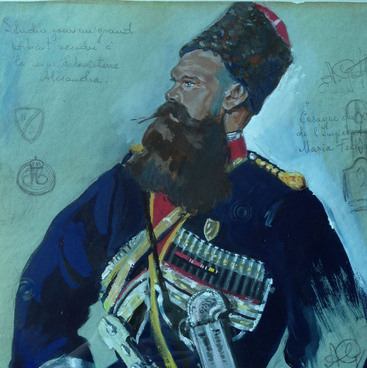In 1792, Empress Catherine II proposed to the Black Sea Cossack army to move to the Kuban and occupy the lands in the lower reaches of the river. There the Cossacks had to protect the borders of the Russian Empire from the attack of the Adygheans. In total, more than 14,000 people were sent to the new region, of which about 8,000 were men. In 1794, the Cossacks founded the city of Ekaterinodar (modern Krasnodar) and 40 ‘kuren’ settlements (units of the Zaporozhian Cossack Host).
On July 13, 1792, the Empress gave an audience to the representatives of the Black Sea Cossack Host. As a ‘housewarming gift’, Catherine handed the Cossacks a salt cellar and a dish made of silver with gilding. The diameter of the dish was 51 centimeters and it weighed 2.5 kilograms. Today it is housed in the collection of the Krasnodar State Historical and Archaeological Museum named after E. D. Felitsyn.
The dish is made of a silver sheet in the technique of shaping or, in other words, hammer forming. This was the name of the method of cold metal processing, in which the product was shaped with a special hammer. Most often, a wooden tool was used, which did not leave scratches on the metal surface. In the old days, not only dishes but also shields or parts of military armor were created by the method of hammer forming.
The rim of the plate is decorated with an embossed garland containing flowers and bows at the junctions. There are stamped heraldic shields in two areas. In the center of each shield is the emblem of Kaluga, which means the dish was made in that city. There is an imperial crown in the center, and below are several horizontal undulated lines, that symbolize the Oka River, on which the city stands.
Several stamps have been preserved on the rim of the plate: one of them belonged to the Kaluga silversmith Maxim Zolotarev, the second one — to the ‘instrument craftsman’ Afanasy Krasilnikov, who decorated the plate.
Other stamps have also been preserved on the exhibit — the emblem of St. Petersburg and the personal mark of the capital’s craftsman Nikifor Moschalkin. The court officials, who followed the order of the Empress, most likely, bought the dish. Then it was added to the category of palace property, and therefore had to be tested one more time by the jewelers in St. Petersburg.
On July 13, 1792, the Empress gave an audience to the representatives of the Black Sea Cossack Host. As a ‘housewarming gift’, Catherine handed the Cossacks a salt cellar and a dish made of silver with gilding. The diameter of the dish was 51 centimeters and it weighed 2.5 kilograms. Today it is housed in the collection of the Krasnodar State Historical and Archaeological Museum named after E. D. Felitsyn.
The dish is made of a silver sheet in the technique of shaping or, in other words, hammer forming. This was the name of the method of cold metal processing, in which the product was shaped with a special hammer. Most often, a wooden tool was used, which did not leave scratches on the metal surface. In the old days, not only dishes but also shields or parts of military armor were created by the method of hammer forming.
The rim of the plate is decorated with an embossed garland containing flowers and bows at the junctions. There are stamped heraldic shields in two areas. In the center of each shield is the emblem of Kaluga, which means the dish was made in that city. There is an imperial crown in the center, and below are several horizontal undulated lines, that symbolize the Oka River, on which the city stands.
Several stamps have been preserved on the rim of the plate: one of them belonged to the Kaluga silversmith Maxim Zolotarev, the second one — to the ‘instrument craftsman’ Afanasy Krasilnikov, who decorated the plate.
Other stamps have also been preserved on the exhibit — the emblem of St. Petersburg and the personal mark of the capital’s craftsman Nikifor Moschalkin. The court officials, who followed the order of the Empress, most likely, bought the dish. Then it was added to the category of palace property, and therefore had to be tested one more time by the jewelers in St. Petersburg.



